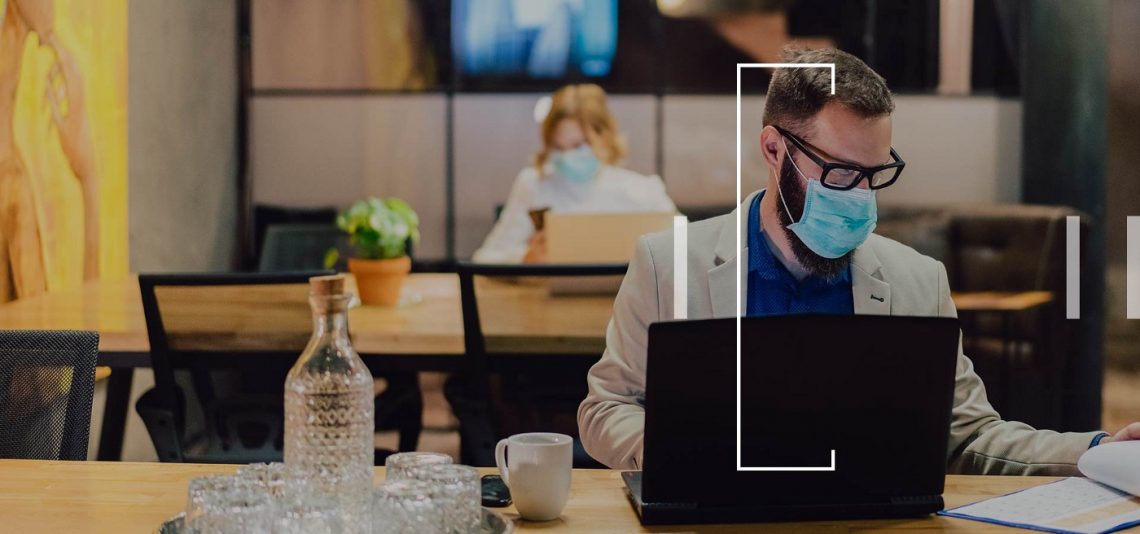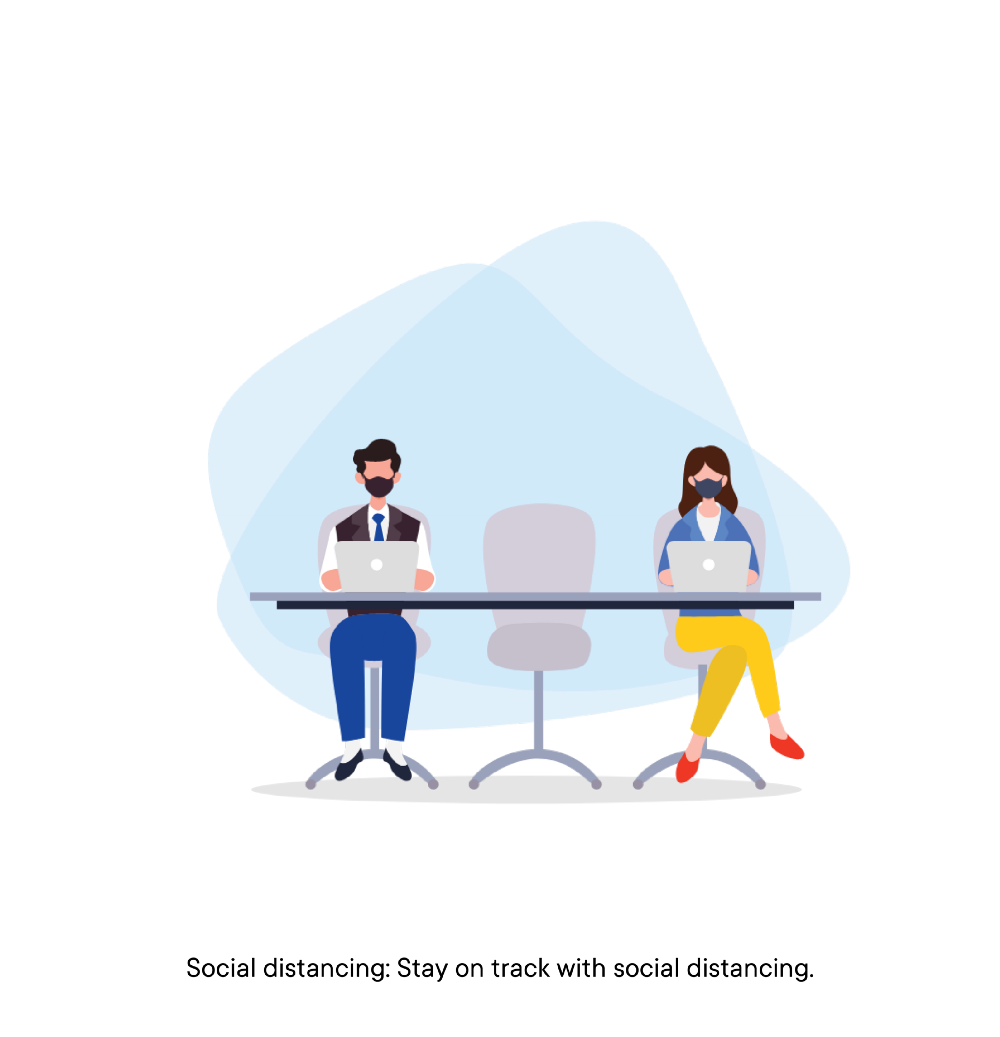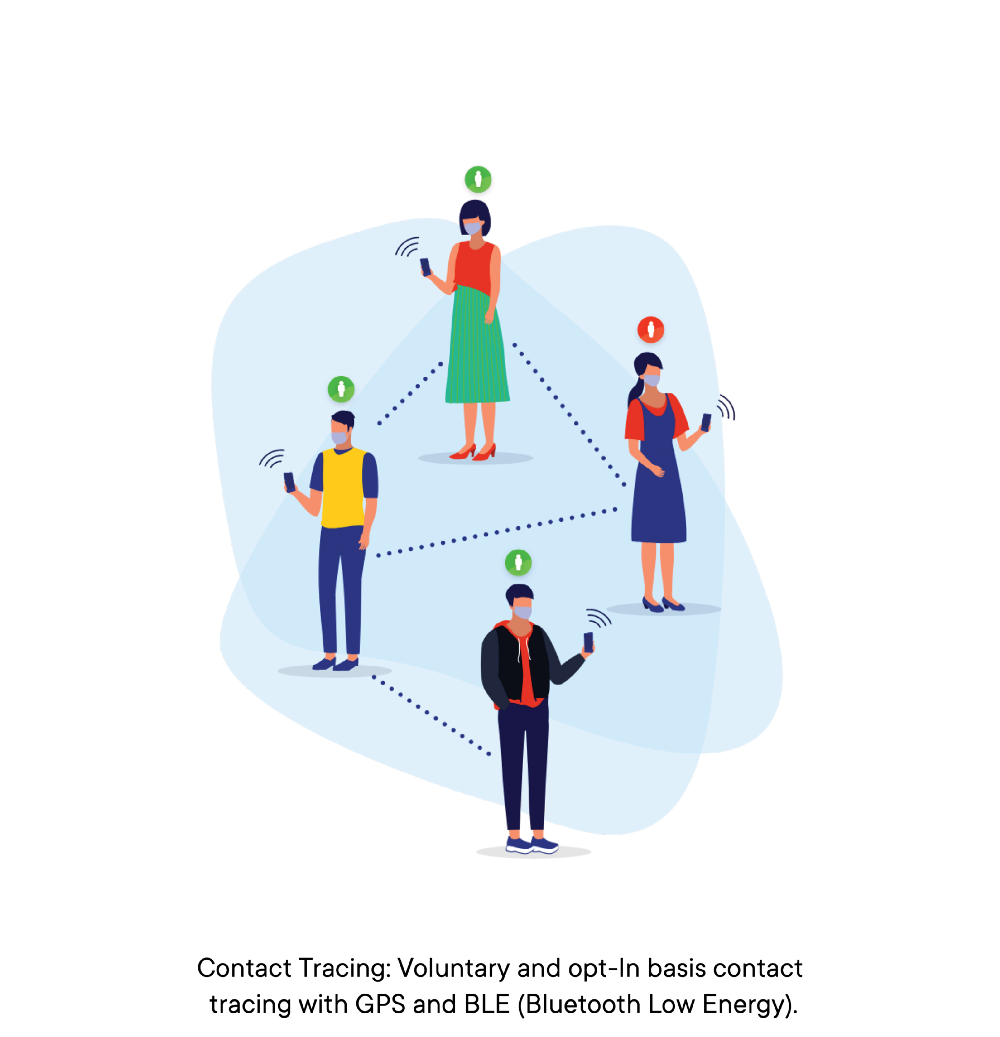ID Alumni Co-lead Infosys’s Return to Workplace Project
January 11, 2021

Tirdad Kiamanesh (MDes 2018) and Douglas Wills (MDes 2006), two ID alumni with very different backgrounds, talk to Lana McClure (MDM 2021) about how lessons from ID aid them in their current roles, including in their current project. The two co-led Infosys’s hybrid Return to Workplace project. Now, their team is working on the next evolution, Infosys Intelligent Workplace Platform, which goes further than bringing employees back safely into physical spaces and considers how work itself is and will be changing post-COVID.
Could you each walk me through your career development that led to ID and where you are now?
Tirdad: I’m a scientist; my undergraduate education is in atomic physics. What I missed working in physics is that you never can finish anything. And I missed working with people and seeing tangible outcomes of the research on my work. That’s how I started to become interested in design, and in particular industrial design. That led me to a master’s in industrial design, product design. Then I came to ID for strategy. So as you see, I’m interested in doing the research and finding common solutions with people and creating something visible and functional.
Douglas: I started out in the communication design world, which really means graphic design for most people. I have an undergraduate degree in finance, but I started working in advertising right away. I liked advertising because it was creative and fit my way of looking at the world. When the Macintosh was first changing everything from print over to desktop publishing, I really became a tech person. But at the same time, I realized I need to be billable and not just be tech. So I started to understand and learn design from really great designers at Bagby Design, VSA Partners, and Meta4 Design. I learned the craft of visualizing and clarifying complex thoughts and ideas. That led me to realize that you can use the same creative process to develop innovation, service models, and other aspects of business.
Several people from VSA Partners went on to ID to get their master’s degrees and I thought it would be a good route too. And so after I went to ID, I ended up getting shipped over to South Korea from Doblin. And then I decided to stay in Korea and I started working for another consulting company called Strategos. That’s where I was able to work underneath Gary Hamel. Then I came back to the US and started doing some teaching under Jeremy at IPRO and then at Northwestern. For about four years now I’ve been at Infosys.
Tirdad, how do you think your science background, coupled with the strategy and design thinking skills you learned at ID, has shaped the work you’re doing now?
Tirdad: What can I say is that when you’re working in something like physics, you are always dealing with ambiguity. You have to figure out how to navigate some degree of ambiguity and find clarity. My background in science balances my analytical and creative mind, which becomes very handy when I am dealing with engineers.
Could you each describe what you’re working on right now?
Douglas: We’re working on a suite of applications that help enterprises and employees safely return to the workplace in a post-COVID environment. But more broadly, we’re trying to go into a company and reframe their original ask, and define the problem we’re really trying to solve and who we’re trying to solve it for. And why that’s important.

Health disclaimer: Self-proclaim status and receive advice on whether to work at the office or from home
Our clients run the whole gamut because our emphasis is doing the systems integration for large companies. We work with basically everybody, most of the Fortune 500 throughout the US and the rest of the world. There probably isn’t anyone we haven’t worked with, but rather than trying to solve these engineering problems right away, we’re usually at the front end to really define how we should approach something. Or if they have an existing problem, how we can reframe the problem rather than go straight to an engineering solution.
Tell us more about the hybrid Return to Workplace project. What is the aim and how will you measure success?
Douglas: So the project aim is to help both the employee and the employer return to the office environment in a meaningful way, and at the same time, mitigate any risks that may be there for the employer or the employee. So it just starts out with very simply just trying to ascertain a baseline for health screening.
This is what we’re trying to solve for: to get people back into the office workspace, to enable those serendipitous interactions that can happen, collaboration. How can we facilitate that in the situation that we find ourselves in, while keeping people safe and reducing the complexity for compliance by the employer?
That’s the challenge. And it sounds simple—I will just create a health disclaimer, you know, a health screener will flow to create this hot desking application and social distancing, but there’s a lot of nuances, once you build all the pieces, there’s a lot of things you have to keep track of. So our team not only had to do that fuzzy front end, but also now we’re in the design phase. And today, I can tell you that the flow diagrams, the flow charts, for each one of those applications are quite complex when you are trying to build all of it.
Tirdad: The thing is that this is not the first pandemic, right? And it’s not going to be the last one. So that was a wake up call for us to be careful about the next one. So I think the measure of success for this project is that, yes, bring people back safe, and prevent the community outbreak. Because we cannot protect individuals 24/7, but we can reduce and control the risk of community outbreak in the building and in the community. That’s the main goal and main KPI, let’s say.
Our strategic design team is continuously searching for new needs and demands, offering innovations that rely heavily on user-centered research and methodologies. We function as trailblazers for our engineering team, always checking with them on the feasibility of our ideas.

The interesting thing about this project is generally applicable to all innovation projects: innovation doesn’t happen in a vacuum. You find a new application, pivot it, improve it, and create a totally new solution.
In this case, for instance, we had the technology to figure out the building’s heat map, to realize which part of the building is more usable, which space people are gathering more to improve energy consumption, and enhance the lighting of the space. Now we figure out that using the same technology, we can understand how to reduce the risk of infection, give space to people so they can follow the social distancing guidelines, and so on.
The other thing is that we work in an agile culture, so everything is happening at the same time. So we have to keep everything documented. Everyone knows what’s happening 24/7.
Douglas: How many people do you think are on it? I think, oh my—50 people, at least or so maybe more than that. This is a large project.

It sounds like the project is an active response to the current state of the world. And since there’s a lot of people working on it, I’m wondering how this impacts your role as the lead designers knowing that the results or the outcomes are going to affect future social norms as well?
Douglas: That’s a great question that the design team always wrestled with. And it makes it even more complex, since we’re a global company with global clients, the norms, the regulations, the laws are different in each EU, region of the US, and definitely between the different countries of the clients that we serve. So we had to take that into account too, not only from a technical aspect, but also how do we make sure that those policies can be adjusted in the different regions? And then just our own ethics when we’re thinking about contact tracing? And you could use this tool for good, and then you can use it for other reasons, too. So how do we mitigate that? Well, so there’s lots of questions like that, that we, as a team had to think through and mitigate. And then you have the clients who are purchasing these, they have their own perspective as well. So those are not simple questions to answer. But these are conversations that need to happen.
And we, after coming out of the Institute of Design, we’re taught to be collaborative and develop conversation. So one of our roles is to do just that: is to help drive and facilitate those conversations, not necessarily dictate the outcome, but help people think through them in a meaningful way. So today, there’s no good final answer to your question, but just more how we approach that collaboratively, driving the conversation and helping people take the road in a meaningful way.
Tirdad: I think this is the main thing that I learned from ID: my job is to advocate for people. It’s not easy. Not everyone wants to hear that in the business world. Sometimes what you find in the research contradicts with the business incentives of the client. So it’s always challenging but for this specific project, I’m very happy that everyone was very respectful about the findings.
Do either of you have any additional advice for current ID students who are soon going to enter the workforce?
Douglas: So I’ll take a stab at it real quick. I’ve been in the professional world for quite some time, and there’s always been a big change happening. And I think this is definitely a big change. But there’s always been a challenge in the work environment—whether it’s a stock market crash, or a war, or, you know, maybe there’s two wars, or it’s the election. I like to stare down the problems. And don’t let them paralyze you. Have a point of view on what you think you can do for people who are already in the thick of things and who have limited time and need help. Help them understand what it is that you bring to the table. And why you can be a part of their team.
Network, talk to lots of people and then make it clear what value you can bring as evidenced by your past projects and your education, and then build that portfolio online to help present that. So don’t think that it’s any more challenging now than it has been in the past or will be in the future, there will always be something that will put a barrier in between you and your future. So you just have to get around that.
Tirdad: I remember Sohrab Vossoughi, founder of Ziba Design, said that he tried to learn mindset, not skills at school, because you can learn about the skills later and the skills keep changing, but mindset is something that takes time to learn. And you can always YouTube and Google and learn about the skills.
And the second piece is maybe very normal advice. Be friends with people at ID, because they are going to hire you later. And don’t burn any bridges there, even after you find a job. And also, try to network with people. I know it’s hard now because everything is digital. But it’s good to talk with people and try to learn about them. When you show that you are interested, the person might think of you when there is an opportunity.
Originally published at Medium.com